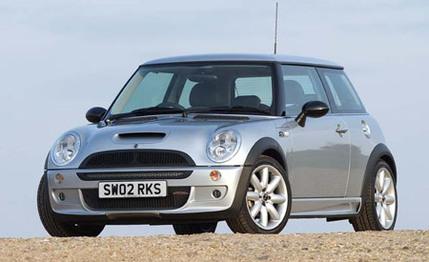
 First Drive Review
First Drive Review
British engineer and designer Sir Alec Issigonis created the tiny 37-hp Mini in 1959 for the Austin and Morris marques, but it was left to John Cooper to make it a truly entertaining device for drivers. Thus, it seems fitting that Cooper's son—John Michael Cooper, who goes by Mike—was handed the job of enhancing the driver-entertainment index of the latter-day Mini.
The key to Mike Cooper's upgrade is more power, just as it was with John Cooper's Mini back in 1961 (from 33 to an ungodly 65 horsepower).
None of this is surprising. Mike Cooper was soaked in speed throughout his youth, in a household frequented by guys like Bruce McLaren, Denis Hulme, Sir Jack Brabham, and Stirling Moss, to name just a few. John Cooper's shops in East Preston, Sussex, England, have been busy ever since creating tuner Minis. (British Motor Corporation ceased production of the original Mini Cooper and Cooper S in 1971, leaving John Cooper to keep it going as a cottage industry.)
So when BMW was developing its product-cycle plans for the Mini revival in 1998, paying a one-time royalty for the Cooper name and then enlisting John Cooper for the eventual performance upgrade made more sense than turning to longtime tuning partner Alpina. Aside from name recognition, it's likely that geography tipped the balance. Alpina is based outside Munich—not exactly consistent with BMW's desire to trade on the Mini's British roots.
John Cooper Works (JCW) offered its first upgrade kit in late 2001, bumping output of the naturally aspirated version of the Mini Cooper from 115 to 132 horsepower. We won't see that package in North America, but we will see the latest version, developed for the supercharged Mini Cooper S. The kits are currently available through 71 Mini dealers in the U.S. and Canada.
Like the kit for the naturally aspirated car, the one for the supercharged S model is designed to enhance engine output only—no suspension or brake upgrades. It's a straight bolt-on, entailing a reprogrammed engine-control chip, a revised cylinder head, a new supercharger, a smaller supercharger drive pulley, and an upgraded exhaust system designed to reduce back pressure.
The bulk of the development time on the S program was devoted to machine work on the cylinder head, aimed at improving intake and exhaust flow. No changes were made to the valvetrain, compression ratio, or crankshaft. The vanes of the new Eaton supercharger are coated with a ceramic compound that provides better sealing, and maximum boost has been bumped from 11.6 to 14.0 psi. Although the system generates more heat than the stock setup, JCW and BMW are confident the Mini's intercoolers and cooling system can handle it without a problem. Similarly, the development team feels the stock clutch and six-speed manual gearbox can deal with the extra thrust.
There's a fair amount of that. The standard Cooper S twirls up 163 horsepower and 155 pound-feet of torque from its 1.6-liter twin-cam 16-valve four. The JCW version generates 200 horsepower and 177 pound-feet of torque. Mike Cooper says they could have mined more from the iron-block, aluminum-head Pentagon engine, but "we stopped at 200 for reliability," not to mention making BMW's warranty people happy, since the JCW kit is covered by the same 48-month/50,000-mile program as any other Mini. This goes for retrofits as well as new cars.
Adding horsepower and torque makes for a quicker Mini. An unofficial estimate by a Mini spokesman forecast a 0-to-60 time of about 6.3 seconds, in contrast to the 7.0-second run we posted in our first Cooper S test (July 2002). Judging by a short day of driving around the southern coast of England, we feel this estimate may be a bit optimistic. The new supercharger seems to spool up a little quicker than the one in the standard S version, and it also seems to provide much better midrange response, reducing the drama of passing maneuvers.
There doesn't seem to be any dynamic downside to the kit. At about 2800 pounds, the Works Cooper S is chunky enough to damp out any hint of torque steer, and the standard brake system feels capable of keeping up with the increased pace. About the only negative is a slightly higher level of supercharger whine, not bad for short stints, but undoubtedly tedious over a long haul.
The big question, though, is whether the additional punch is worth the money. Mini's marketing minions hadn't finalized pricing as we went to press but were willing to estimate the U.S. price for the kit at about $5000, a figure that includes the nine-hour installation process, to be handled either at the port of entry or through a dealer.
That figures to about $135 per horsepower, and it also makes for a pretty pricey Mini. Adding the JCW kit to a Cooper S propels you right up against the 25-grand frontier, without adding extras such as leather, a sunroof, 17-inch wheels, or xenon headlamps. Should we choose to bolt the kit to the Cooper S that's just joined our long-term test fleet, we'd be looking at a $28,815 Mini, and that's the threshold of Mazda RX-8 and Nissan 350Z territory.
From that perspective, you have to ask yourself, "Do I really need this?" And then you have to provide the answer.